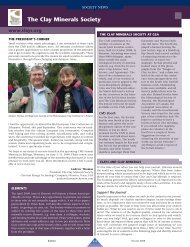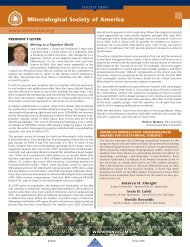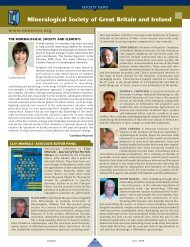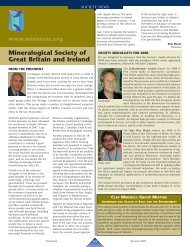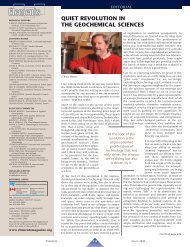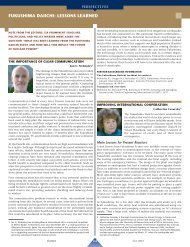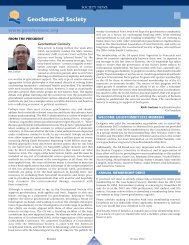MinerSoc - Elements Magazine
MinerSoc - Elements Magazine
MinerSoc - Elements Magazine
- No tags were found...
Create successful ePaper yourself
Turn your PDF publications into a flip-book with our unique Google optimized e-Paper software.
Mineralogical Society of Great Britain and Irelandwww.minersoc.orgFrom the Executive DirectorMineralogical Society and EMU to Co-PublishEMU Notes in Mineralogy SeriesFollowing negotiations during the summer, representatives of theEuropean Mineralogical Union and the Mineralogical Society havesigned a memorandum of understanding so that from now onwards,they will work together in the publication of the renowned EMU Notesin Mineralogy series. This series will now be produced through theMineralogical Society’s London office and marketed and sold fromthere. Mineralogical Society President Michael Carpenter commented:“This is an excellent opportunity to use the expertise of the MineralogicalSociety on a project of benefit to all the European Societies. There willbe benefit for both organizations and undoubtedly a wider audience forthe series.” The books will be sold via an online EMU bookshop, hostedby the Mineralogical Society, of which more details will be availableshortly.MinSoc Gets Facetime with MembersThe Mineralogical Society now has its own Facebook page.Go to www.minersoc.org and click on the Facebook logo,which you will find on the homepage. Facebook allows the Society tobe more proactive in telling members and others about its activities.Student and Senior Bursaries for 2010The deadline for applying for Society bursaries is 15 January 2010.Anyone can apply, and there is a total fund of £6000 available each year.Go to www.minersoc.org/pages/awards/awards.html for details on howto apply and an application form.Call for Nominations for 2011 Society AwardsThe Society now awards three medals, the Schlumberger Medal, theMax Hey Medal and the Collins Medal. The closing date for nominationsis 30 April 2010. Go to www.minersoc.org/pages/awards/awards.htmlfor information about how to make a nomination.2009–2010 Distinguished Lecturers ProgrammeThe Distinguished Lecturers for the academic year 2009– 2010 are Prof.Tony Fallick and Prof. David Manning. Each will lecture at four venues.Go to www.minersoc.org/pages/lecturer/lecturer.html for informationabout the venues, dates and times, and to read the abstracts.44 th -Annual VMSG Conference, Glasgow, 4–6 January 2010The Volcanic and Magmatic Studies Group is a joint special interestgroup of the Mineralogical Society and the Geological Society. Thetwo-day annual conference will bring together researchers from allfields. Conference themes include: magma transport versus magma storage;geochronology of igneous processes; isotopes as records of magmaticprocesses; transport, dispersion and deposition during volcanic eruptions;and volcano-tectonics: lessons from the field and laboratory.For more information, visit http://web2.ges.gla.ac.uk/VMSG33 rd -Annual MDSG Conference, Glasgow, 5–7 January 2010The 33 rd Mineral Deposits Studies Group meeting will gather UK andinternational scientists for a series of lecture and poster presentations.The latest ideas on mineral deposits science will be aired by establishedacademic, industrial and post-graduate members and guests, all in aninformal, welcoming environment.Keynote presentations:• Professor Jake Lowenstern – Magma intrusion, degassing,and hydrothermal setting of the Yellowstone Caldera• Professor Dick Tosdal – Tectonic transitions in theporphyry-epithermal environment• Professor Gaston Giuliani – Academic and economic geologyof precious coloured gemstones: an updateAll are welcome – and Mineralogical Society members will receive asignificant discount on registration costs. Student registration costs arenominal, and all students will receive a bursary (up to £80) at the meeting,thanks to the generosity of our sponsors. Register at: www.mdsg.org.ukor email a.boyce@suerc.gla.ac.uk.Sustaining MembershipThe Society’s Sustaining Membership scheme has been launched. Allmembers were invited to make a contribution to the student fund atthe same time as the membership renewal reminders were sent out. Pleasedo consider making a donation. This is one of the best ways to supportour subject. The Society offers cut-price membership (free to studentsfor the first year), conferences at which student presentations are welcomedand encouraged, and travel bursaries. An ad hoc committee hasalso been set up to encourage corporate partnerships between theSociety and industry, and the first letters have been sent out. Donationsfrom these groups will also be included in the student fund.Kevin Murphykevin@minersoc.orgAnnual Conference 2009: MicroAnalysis, Processes, Time MeetingTwo hundred mineral and geoscientists gathered in Edinburgh inlate August/early September for the MicroAnalysis, Processes, Timemeeting, the annual meeting of the Mineralogical Society, jointlyorganized with the Société Française de Minéralogie et de Cristallographieand the Deutsche Mineralogische Gesellschaft, and attended byrepresentatives from 23 countries. There was a busy programme, withtwo field trips, two short courses and three days of oral and posterpresentations. A full report is available at www.minersoc.org/pages/meetings/MAPT/MAPT.html.During the conference banquet, the Max Hey Medal and the SchlumbergerAward were presented to Dr Andrew Walker and Prof. JohnBrodholt, respectively. A podcast of the award speeches is availablefrom the meeting report page.Prof. Ben Harte deliveredthe 39 th HallimondLecture during the MAPTconference.Prof. J. Brodholt, winnerof the SchlumbergerMedal for 2009Dr A. Walker, winner of the2009 Max Hey Medal<strong>Elements</strong> 390December 2009386-400_ELEM_v5n6.indd 390 09-12-14 14:35
Lochaber Geopark – Ardnamurchan LighthouseTaigh Solas Aird nam MurchanArdnamurchan Point, in the Lochaber district of western Scotland, isthe most westerly point of mainland Britain, at 6°13’ W. The lighthouse,designed by Alan Stevenson, of the celebrated Stevenson family of engineers,was opened in 1849. It is constructed of beautifully fitted, curvedblocks of granite from the Ross-of-Mull, dovetailed in three dimensions.It stands on hypersthene gabbros of Centre 2 of the PalaeogeneArdnamurchan Central Complex, with its dramatic ring structures, andprovides stunning views of the plutonic centres of the islands of Rumand Skye and the lavas of Eigg and Mull.As elsewhere in Scotland, the great light now runs automatically. Thebuildings have been developed as a visitor centre by ArdnamurchanLighthouse Trust, who approached the Lochaber Geopark Association,part of the European Geoparks Network, to establish a geological displayin one of the outbuildings. LGA is a charity, with most of its interpretativeand educational work done by volunteers like myself, and MinSocvery kindly provided £500 towards display cabinets for local mineral,rock and fossil specimens. Motorists approaching Ardnamurchan fromthe east pass through Strontian, where they see a board bearing the words‘Strontian, the village that gave its name to the element Strontium’ (see<strong>Elements</strong> 4: 216). We have assembled samples from the mines, includingstrontianite and brewsterite from this type locality, as well as examplesof the rock types of the Ardnamurchan complex. Motorists can also arriveon the ferry from Tobermory, on Mull, to Kilchoan, a journey that is perhapsunique because both villages have minerals named after them!Senior Bursary ReportInternational Discussion Meeting on ContinentalGeology and Tectonics – Xi’an, China, September 2009In 1993, when I visited the fledgling Earth Sciences Department atthe University of Hong Kong, it was pointed out to me that Chinawas virtually untouched by modern geological research and thatthere were “easily 300 PhDs out there, waiting to be done”. Muchhas changed in the intervening 16 years, and now China is becominga scientific force to be reckoned with. After much recent investmentin geochemical instrumentation, the country is producing a hugevolume of high-quality geochemical data.Hugh Rollinson (far right) with other members of the post-conference fieldexcursion to the Dengfeng area of the North China Craton. Photo Anlin GuoThe permanent exhibition was opened on 8 September, with MinSocrepresented by Kate Dobson and David Brown of Glasgow University.With admirable timing, the British Geological Survey was able to providea first copy of its beautiful new map of Ardnamurchan. The wallsare occupied by interpretative boards at two levels: Low down, childrentravel through time with a friendly dinosaur and a sheep in a rocketpropelledlighthouse. Higher up, adults travel from the Neo-Proterozoic,through the Caledonian collision and the opening of the North Atlantic,finally arriving in post-glacial times when the internal workings of thevolcanic centres were revealed.Ian Parsons, University of EdinburghThe discussion meeting entitled ‘Continental Geology and Tectonics’was hosted by Northwestern University, in Xi’an, China, and gatheredabout 20 senior western scientists and a larger number of Chinesescientists. The principal themes of the meeting and post-conferencefield trips were Precambrian crustal evolution and the genesis ofintercontinental orogenic belts. For me this was an importantmeeting inasmuch as it opened my eyes to another Archaean craton– the North China Craton. This craton is significant in crust evolutionmodels for having allegedly lost its underlying mantle lithospheresometime during the Mesozoic and is perhaps the prime exampleof cratonic lithosphere delamination. After having visited the area, thegeological literature on this important region is for me more meaningfuland more intelligible. I am grateful to the Society for their support. (ReadHugh’s full report at www.minersoc.org/pages/awards/bursary.html).Hugh Rollinson, University of Derby, UKMineralogical <strong>Magazine</strong> and Clay MineralsThe latest tables of contents are available at http://gsminmag.highwire.org/and http://gsclaymin.highwire.org/, respectively. Here are just someof the interesting papers you will find:• Plastic deformations in kyanite by tectonometamorphicprocesses: a single-crystal X-ray diffractionstudy – G.D. Gatta, N. Rotiroti, and M. Zucali• Zigrasite, MgZr(PO 4 ) 2 (H 2 O) 4 , a new phosphate mineralfrom the Dunton Quarry, Newry, Oxford County,Maine, USA – F.C. Hawthorne, N.A. Ball, J.W. Nizamoff,and W.B. Simmons• Synchrotron X-ray absorption spectroscopy andX-ray powder diffraction studies of the structure ofjohnbaumite [Ca 10 (AsO 4 ) 6 (OH,F) 2 ] and synthetic Pb-, Sr- and Ba-arsenateapatites and some comments on the crystal chemistry of the apatitestructure type in general – C.M.B. Henderson, A.M.T. Bell, J.M. Charnock,K.S. Knight, R.F. Wendlandt, D.A. Plant, and W.J. Harrison• Natural nanoclays: applications and futuretrends – a Chilean perspective – M. Calabi Floody,B. K. G. Theng, P. Reyes, and M. L. Mora• Comparing the efficiency of ordinary krigingand cokriging to estimate the Atterberg limitsspatially using some soil physical properties – O.Baskan, G. Erpul, and O. Dengiz• Characterization of size, aspect ratio and degreeof dispersion of particles in filled polymericcomposites using FIB – Y. Zhu, G.C. Allen, J.M.Adams, D. Gittins, P.J. Heard, and D.R. SkuseMembers with a subscription can access theseand other papers online by logging in (you’ll need your membershipnumber) at the Mineralogical Society website homepage (www.minersoc.org).<strong>Elements</strong> 391December 2009386-400_ELEM_v5n6.indd 391 09-12-14 19:00




